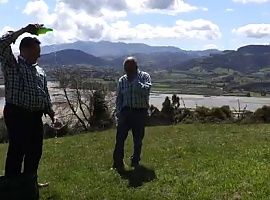NANGARHAR, Afghanistan) — For the first time during this deployment, members of the Nangarhar Provincial Reconstruction Team walked the streets of Jalalabad, Afghanistan, asking local shop owners about the economy and their opinions on their government.
Although previous PRTs in Nangarhar have done market assessments, the current team has focused largely on provincial level governance and development; however, after more than three months here, it was time to see how things were shaping up on the ground, said U.S. Army Capt. James Hanson, PRT civil affairs team lead.
“We gained a snap shot of the local economy and what is really going on in the market place on a daily basis,” said Hanson, a native of Cornell, Mich. “We also gained an understanding of the local businesses and how the government is helping or not helping them.”
The PRT relies primarily on key leaders for information about what is happening in the community, but getting a true sense of what is important or impacts the local citizens of Jalalabad requires talking with everyday people, said U.S. Army Sgt. Kristin Goehler.
“We gained real atmospherics by interacting directly with locals rather than relying on information second-hand,” said Goehler, a Milwaukee native. “We also portrayed a positive image of coalition forces by direct interactions with the locals.”
The market patrol was comprised of several small teams of PRT civil affairs Soldiers, was broken into three smaller, two-person teams along with a PRT security force to ensure the safety of the civil affairs teams as they performed their mission.
“This was a group effort with civil affairs, security force and headquarters elements to pull this all off,” said Hanson, who is deployed from the 432nd Civil Affairs Battalion, an Army National Guard unit out of Green Bay. “There are many moving parts to this type of mission and everyone has to do their part to conduct this type of mission successfully.”
As the two-hour mission progressed, the market the team walked through became increasingly more congested with shoppers, added Hanson. Likewise, the team attracted a lot of attention from children and others interested in what the service members were doing.
“We had a good plan and were able to move the way we wanted to despite how crowded the market was,” said Goehler, who is from the same unit as Hanson. “It is a testament of how good the different elements worked together.”
With more people, the team got a better feel for the economy, said Hanson. Nearly every shop, which included clothing, jewelry and food, had customers.
“A large number of people in the market indicate the area is secure,” said Hanson. “People have faith in the economy and are not hording money for a rainy day. This is exactly what we were hoping to find while conducting our assessment.”
There were also a large number of local women shopping, said Goehler, whose small team was designed primarily to engage women. Unlike many other areas, the women were without male escorts, which indicates an added sense of security.
“The interaction with the women was positive,” said Goehler. “They felt very safe shopping in that market. It shows when women have the freedom of movement to shop without an escort. One woman we talked to has had her own shop for 10 years and supports her family with her sales.”
Although this marked the first market walk for the PRT, plans are already in the works to do another one, said Hanson. The goal is assess various markets throughout the province, helping not only get a pulse for the important issues and the economy but also to assist in market research for construction supplies, which is another area of PRT efforts.
“I did not experience any negative feedback, and all the interaction was positive,” said Goehler. “The people were receptive to answering our questions, and everyone was accommodating.
PRT gauges local economy in Jalalabad




















